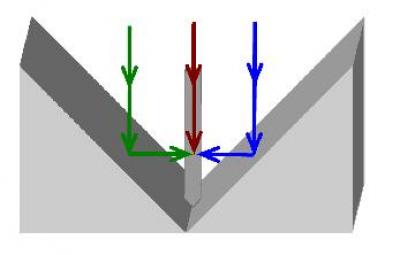Oct 22 2012
Enhanced local electric fields are predominant in nonlinear optical properties, particularly in surface-enhanced Raman scattering (SERS), which is a sensitive technique used for the detection of trace amounts of chemicals. Analysis of the electric fields around nanostructures indicates that they can provide a basic foundation to obtain greater SERS intensity.
 This is a schematic presentation for illustration of the superposition of the incident waves in the nanorod-groove system. Credit: ©Science China Press
This is a schematic presentation for illustration of the superposition of the incident waves in the nanorod-groove system. Credit: ©Science China Press
Professor ZHANG Zhongyue and his group from the College of Physics and Information Technology at Shaanxi Normal University have proposed a novel scheme to enhance the local electric fields around nanostructures. The scheme is based on manipulation of the incident wave to allow the superposition of the electric fields of multiple beams of light to work as the excitation source for the electrons in the nanostructures, and larger electric fields are thus excited around the nanostructures. Their work, entitled "Enhancing the electric fields around the nanorods by using metal grooves", was published in SCIENCE CHINA Physics, Mechanics & Astronomy 2012, vol. 55 (10).
SERS is one of the most promising applications of the enhanced optical fields generated by the excitation of local surface plasmons in metal nanostructures. The SERS spectrum reveals the vibration modes of molecules, thus conveying specific information with fingerprint-level accuracy. Also, the sensitivity of SERS is one of the highest among the currently available analytical techniques, potentially leading to single molecule detection. Although the SERS signal from a particular molecule originates from both chemical and electromagnetic contributions, the dominant factor in SERS is a result of the local electromagnetic field enhancement caused by the resonant excitation of localized surface plasmons in metal nanostructures. Because the surface plasmon resonance depends strongly on the shape of the nanostructures, nanostructures with different topological shapes were prepared to enhance the local electric fields. It was found that nanostructure pairs and nanogalaxies could also achieve stronger electric fields because of the electric field couplings or cascade electric field enhancements in the nanosystems.
Unlike previous methods of building the SERS substrates, ZHANG Zhongyue and his group presented a novel scheme to enhance the electric fields around the nanostructures. By manipulating the incident wave, the superposition of the electric fields of multiple beams of light works as the excitation source. When the phase differences between the multiple beams of light are designed appropriately, the excitation fields for electron oscillations in the nanostructures are much greater than those at normal incidence. The electric fields around these nanostructures are also larger than those at normal incidence. The starting point of this scheme is the enhancement of the excitation field for the electron oscillations in the nanostructures, which does not conflict with previous designs that varied the topological shapes of the nanostructures or combined nanostructures to generate larger electric fields.
Following the previously discussed schemes, ZHANG Zhongyue and his group presented the silver nanorod-groove system for SERS substrates. The grooves are used to manipulate the incident waves. The superposition of the electric fields of multiple beams of light works to excite the electron oscillations in the nanorods. As a result, the electric fields around the nanorods in the nanorod-groove system are much greater than those around individual nanorods and those in the nanorod-film system.
For the nanorod-groove system, even with fabrication defects related to the oblique angle of the groove and the location of the nanorod, numerical calculations also show that larger electric fields can be excited around the nanorods. Although the separation distances between the nanorods affect the electric field distributions, the electric fields are always larger than those around individual nanorods and those around the nanorods in the nanorod-film system. Therefore, the nanorod-groove system provides a good structure to further enhance the local electric fields around the nanorods.